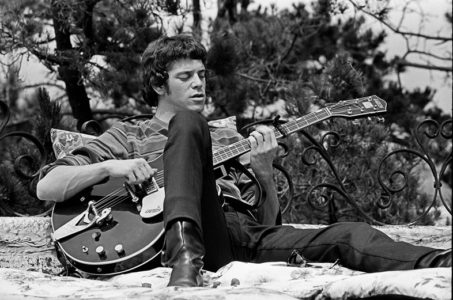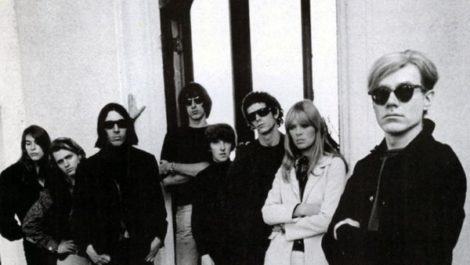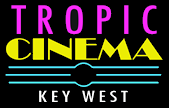The Velvet Underground
Front Row at the Movies by Shirrel Rhoades
[mr_rating_result]My old friend Paul Morrissey was Andy Warhol’s manager and confidant. Brash and outspoken, Paul’s long-term collaboration with the low-keyed, taciturn artist has been described as “a successful mismatch.”
 Paul has directed more than two-dozen films, many under the imprimatur of “Andy Warhol Presents …” Paul always groused to me that Andy got credit for his films, although he admittedly used the Pop Artist’s coattail to give his films like “Flesh” (1968), “Trash” (1970), and “Heat” (1972) a certain legitimacy. Paul received an official tribute for these films at the 55th Cannes Film Festival.
Paul has directed more than two-dozen films, many under the imprimatur of “Andy Warhol Presents …” Paul always groused to me that Andy got credit for his films, although he admittedly used the Pop Artist’s coattail to give his films like “Flesh” (1968), “Trash” (1970), and “Heat” (1972) a certain legitimacy. Paul received an official tribute for these films at the 55th Cannes Film Festival.
But Paul did more than direct films and manage Andy’s affairs. As he tells it, he organized and oversaw The Velvet Underground, the rock group that served as the house band for Andy Warhol’s art collective known as The Factory.
“Chelsea Girls” actress Mary Malanga denies Morrissey’s claim that he discovered The Velvet Underground, saying that it was underground filmmaker Barbara Rubin who introduced the band to Warhol. But there’s no question Paul fulfilled Warhol’s role as manager of the group.
The original band lineup consisted of singer/guitarist Lou Reed , multi-instrumentalist John Cale, guitarist Sterling Morrison, and drummer Angus Maclise (shortly thereafter replaced by Moe Tucker and others). They were joined by German singer/model Nico. Doug Yule eventually replaced Cale, and went on to front the band after everyone else left.
From 1966 to 1967, The Velvet Underground traveled in Andy Warhol’s multimedia show called The Exploding Plastic Inevitable (or EPI). It consisted of musical performances by The Velvet Underground and Nico, screenings of Warhol’s films, and performances by regulars of Warhol’s Factory.
The group produced four classic albums – nobody counts the fifth. The first one (simply titled “The Velvet Underground & Nico”) only sold 30,000 or so copies but “everyone who bought one of those 30,000 copies started a band,” says record producer Brian Eno. Among those influenced were David Bowie, Patti Smith, R.E.M., and Beck.
NPR has called it “the definitive way-ahead-of-its-time album.” It ranked No. 13 on Rolling Stone’s list of the 500 Greatest Albums of All Time.
Also, Rolling Stone ranked The Velvet Underground as No. 19 on its list of Greatest Bands. The band was inducted into the Rock and Roll Hall of Fame in 1996.
Music critic Robert Christgau considered them “the number three band of the ‘60s, after, the Beatles and James Brown and His Famous Flames.”
 Maybe you’ve never heard of them. Their innovative music was never very mainstream. But there have been several documentaries made about The Velvet Underground:
Maybe you’ve never heard of them. Their innovative music was never very mainstream. But there have been several documentaries made about The Velvet Underground:
Andy Warhol and Paul Morrissey filmed a recording session titled “The Velvet Underground and Nico: A Symphony of Sound” in 1966. Others include “The Velvet Underground: Psychiatrist’s Convention, NYC, 1966”; “The Velvet Underground Tarot Cards”; “The Velvet Underground Eats Lunch”; “Exploding Plastic Inevitable”; “The Velvet Underground at Bataclan ‘72”; and “Velvet Underground: Velvet Redux Live MCMXCIII.”
Now we have another. Simply titled “The Velvet Underground,” this documentary is helmed by Oscar-nominated director Todd Haynes. It had its world premiere at the Cannes Film Festival on July 7, 2021. You can catch it this coming week at Tropic Cinema – as well as on Apple TV+.
Hired by Universal Music Group to direct and produce the documentary, Haynes received the co-operation of surviving members of the band, John Cale and Maureen Tucker. Singer Lou Reed died of liver cancer in 2013 and guitarist Sterling Morrison died of non-Hodgkin’s lymphoma in 1995. Nico died in a motorcycle accident in 1988.
Todd Haynes is best known for his lush melodramas like “Carol” and “Far From Heaven.” But he’s no stranger to the music world. He looked at David Bowie and glam rock with “Velvet Goldmine,” Bob Dylan with “I’m Not There,” and created ripples with his earlier experimental short “Superstar: The Karen Carpenter Story” (made while he was in college).
But this is his first actual documentary.
Not much footage of the band exists, so “The Velvet Underground” doesn’t give us a lot of extended concert sequences like most music docs do.
However, because the people in Warhol’s entourage were always filming, there’s ample footage of core members and other artists, friends and musicians. Editors Alfonso Goncalves and Adam Kurnitz have helped Haynes cobble together a “treasure trove” of never-before-seen live footage, obscure Andy Warhol films, and interviews with band members and other key figures. The doc often uses split screens, jarring edits, and shots of band members simply staring into the camera to tell the story.
Having little concert footage, Haynes turns the movie itself into a performance. The Velvets’ music is omnipresent throughout the film.
The music was groundbreaking, but also alienating. After a show, the band would take inventory of how many people walked out during their set. Drummer Maureen Tucker says they used to ask, “How many people left? Oh, about half? We must have been good tonight.”
How good is Todd Haynes’s doc? Check how many people leave the theater.
Email Shirrel: srhoades@aol.com


Ratings & Comments
[mr_rating_form]